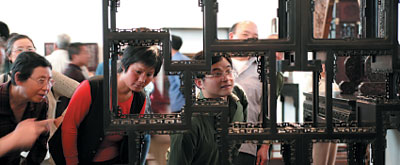| Tools: Save | Print | E-mail | Most Read |
| Good Wood on Antiques |
| Adjust font size: |
One place to appreciate the real, rare red sandalwood furniture of the Ming and Qing dynasties is to visit the Almost 20,000 visitors took advantage of free entry to the museum on May 18, International Museum Day, where they enjoyed the genuine antique furniture and reproductions.
Squatting in front of a Ming-Dynasty cabinet, Gao Jianhua, a furniture enthusiast from Pointing at the simple flowers carved at the bottom of the four round end legs, Gao said that if it were made in Qing Dynasty (1644-1911), there would be many more leaves and petals to depict flowers. Moreover, the round shape of each leg is a feature of Ming furniture. Many female visitors showed great interest in a imitation bridal chamber in the The most precious furniture is made of red sandalwood, rosewood and red wild jujube wood, said Qu Xiaolin, a staff member of the museum. As a sandalwood tree can only grow one-third of a meter in 500 years, the logs for such furniture is rare, and some businessmen dealing in the ancient furniture treat common wood with a dark stain and sell it as "sandalwood". The museum, founded in 1999, is located near the Gaobeidian ancient furniture market, a street where 300 stores sell antique Chinese furniture and reproductions, along Jingtong (Beijing-Tongzhou) expressway. The museum has become a window into the culture of ancient furniture. After visiting the museum, it is advisable to pay a visit to the nearby furniture market. (
|
| Tools: Save | Print | E-mail | Most Read |
 |
| Related Stories |
|
Product Directory China Search |
Country Search Hot Buys |
